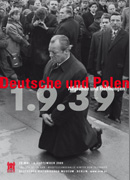


Exhibition | Oppression and Self-assertion | War and Occupation | Conflicts and Rapprochements
The Federal Republic of Germany and Poland Through 1989
| "Friendship" under the Socialist Order
Memories of the War and Polish Perception of Germany
| "A Difficult Episode"
Poland supported German reunification despite its lingering fear of German power, and the treaties signed by Germany and Poland in 1990 and 1991 laid the groundwork for a new partnership. Since then, contacts between the two countries have been intensified on all levels, although differences remain on individual questions. This new status quo between Germany and Poland demonstrates that "normal" relations can withstand the occasional conflict.
Even today, memories of the war, the Nazi occupation and the expulsions are subjects of controversy in the media and political life of both countries. But after all, these issues are contentious even among Germans, as they are among Poles as well. These debates demonstrate that Polish-German history continues to be, in the words of Polish Foreign Minister Władysław Bartoszewski when addressing the German Parliament in 1995, a "difficult episode".
